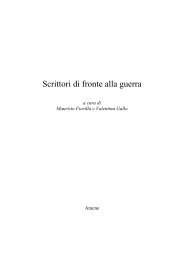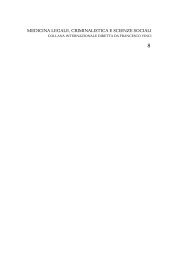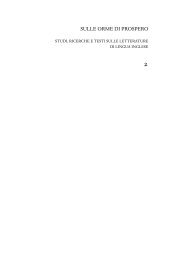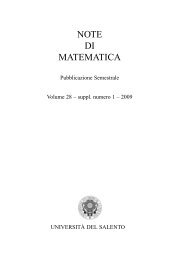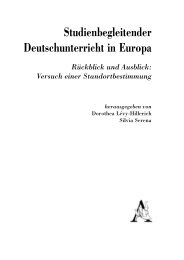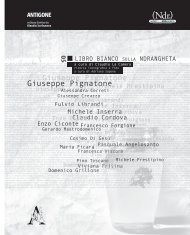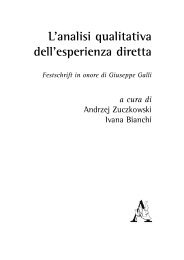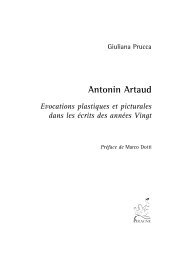Scritture femminili: da Mary Wollstonecraft a ... - Aracne Editrice
Scritture femminili: da Mary Wollstonecraft a ... - Aracne Editrice
Scritture femminili: da Mary Wollstonecraft a ... - Aracne Editrice
Create successful ePaper yourself
Turn your PDF publications into a flip-book with our unique Google optimized e-Paper software.
<strong>Scritture</strong> <strong>femminili</strong>:<br />
<strong>da</strong> <strong>Mary</strong> <strong>Wollstonecraft</strong> a<br />
Virginia Woolf<br />
Atti del Convegno in ricordo di<br />
Gabriella Micks (Pescara, 24-25 ottobre 2007)<br />
a cura di<br />
Andrea Mariani<br />
Francesco Marroni<br />
Massimo Verzella
Copyright © MMIX<br />
ARACNE editrice S.r.l.<br />
www.aracneeditrice.it<br />
info@aracneeditrice.it<br />
via Raffaele Garofalo, 133 a/b<br />
00173 Roma<br />
(06) 93781065<br />
ISBN 978-88–548–2932-9<br />
I diritti di traduzione, di memorizzazione elettronica,<br />
di riproduzione e di a<strong>da</strong>ttamento anche parziale,<br />
con qualsiasi mezzo, sono riservati per tutti i Paesi.<br />
Non sono assolutamente consentite le fotocopie<br />
senza il permesso scritto dell’Editore.<br />
I edizione: novembre 2009
Indice<br />
Prefazione 9<br />
Nora Crook<br />
Who Wrote Frankenstein? 13<br />
Sandro Jung<br />
Sensibility, Class and Comedy in<br />
Radcliffe’s The Mysteries of Udolpho 33<br />
Michela Vanon Alliata<br />
Il diario segreto di <strong>Mary</strong> Shelley 51<br />
Lilla Maria Crisafulli, Keir Elam<br />
Valperga di <strong>Mary</strong> Shelley e la polifonia della storia 73<br />
Colomba La Ragione<br />
<strong>Mary</strong> <strong>Wollstonecraft</strong>: Lettere <strong>da</strong>lla Scandinavia 99<br />
Paola Partenza<br />
“Was not the world a vast prison, and women born slaves?”:<br />
un paradigma filosofico letterario in <strong>Mary</strong> <strong>Wollstonecraft</strong> 137<br />
Alfonso Viola<br />
Le eroine gotiche nei drammi e nelle tragedie storiche<br />
di Byron e l’episteme romantica 151<br />
Paola Evangelista<br />
‘Paesaggi musicali’: quattro poesie di Emily Brontë 163<br />
Anna Enrichetta Soccio<br />
Elizabeth Gaskell, le donne e il problema dell’interpretazione 173<br />
Allan C. Christensen<br />
Performing Artistry in the Novels of Henrietta Jenkin 189
6 Indice<br />
Raffaella B. Sciarra<br />
Gender e mesmerismo in The Lifted Veil di George Eliot 217<br />
Emanuela Ettorre<br />
“Women travel differently”:<br />
<strong>Mary</strong> Kingsley e la scrittura di viaggio 229<br />
Eleonora Sasso<br />
“<strong>da</strong>rkness that can be felt”: la poetica della malinconia<br />
di Elizabeth Eleanor Sid<strong>da</strong>l Rossetti 241<br />
Renzo D’Agnillo<br />
Female Vision and Experience<br />
in D. H. Lawrence’s The Rainbow 257<br />
Raffaella Antinucci<br />
Jean Rhys and the Duplicity of Landscape 273<br />
Michele Russo<br />
The Planter’s Northern Bride (1854) di Caroline Lee Hentz: 285<br />
allegoria edenica o messa in scena di denuncia?<br />
Leo Marchetti<br />
Margaret Collier in Rome and by the Adriatic 305<br />
John Paul Russo<br />
“Mingled love and wonder”: Vernon Lee on Travel and Leisure 313<br />
Alan Shelston<br />
“Tell all the truth but tell it Slant”: Concealment and<br />
Self-revelation in the Poetry of Sylvia Plath 333<br />
Cristina Giorcelli<br />
Intermedialità e intertestualità in Willa Cather:<br />
The Professor’s House 343<br />
Carlo Martinez<br />
Il local color di <strong>Mary</strong> Noailles Murfree<br />
tra turismo ed eterotopia 367
Indice 7<br />
Silvia La Regina<br />
Inediti di Gabriella Micks 389<br />
Notizie sugli autori 401
Prefazione<br />
Quando, nell’autunno del 2004, Gabriella Micks comunicò<br />
ai colleghi e agli amici della Facoltà di Lingue dell’Università<br />
“Gabriele d’Annunzio” la sua intenzione di an<strong>da</strong>re fuori ruolo<br />
qualche anno prima di quanto tutti noi ci aspettassimo (e molto<br />
prima di quanto avremmo desiderato) sembrò a tutti importante<br />
attivarsi per pubblicare, in tempi ragionevolmente brevi, un volume<br />
di saggi in suo onore, col quale manifestare concretamente<br />
l’unanime riconoscimento della sua eccezionale dedizione alla<br />
di<strong>da</strong>ttica e della misura con cui la sua ricerca aveva contribuito<br />
al prestigio dell’Istituzione in cui aveva operato per tanti anni.<br />
Erano stati anni anche difficili, di assiduo impegno, ma certamente<br />
fruttuosi e, in definitiva, assai gratificanti, <strong>da</strong> quando il<br />
corso di laurea in Lingue e Letterature Straniere, attivato<br />
all’interno della Facoltà di Economia e Commercio, si era reso<br />
autonomo con l’inaugurazione di una nuova Facoltà.<br />
Nell’arco di poco più di un anno uscì L’arguta intenzione:<br />
studi in onore di Gabriella Micks (Napoli, Liguori, 2006), risultato<br />
dei contributi di oltre una trentina di studiosi; non è difficile<br />
immaginare la sorpresa e la gioia con cui Gabriella lo vide e lo<br />
“gustò”, quando una scelta delegazione di colleghi della Facoltà e<br />
dell’Ateneo gliene consegnò alcune copie a Salvador de Bahia, in<br />
Brasile, dove si era momentaneamente stabilita. Era, invece, difficile<br />
immaginare, e poi accettare, che Gabriella fosse destinata<br />
a non sopravvivere a lungo a quei momenti di impagabile soddisfazione.<br />
La sua scomparsa ha lasciato un grande vuoto, ancora nettamente<br />
percepibile, anche a distanza di anni; il che accade<br />
sempre nel caso di studiosi che abbiano saputo naturalmente,<br />
senza nessuno sforzo o impegno “programmatico”, coniugare<br />
l’attenta in<strong>da</strong>gine su tematiche pertinenti alle loro competenze,<br />
con una ben più vasta e sana curiosità nei confronti di tante altre<br />
aree e province della cultura, nonché (cosa forse ancora più ra-
10 Prefazione<br />
ra) con una di<strong>da</strong>ttica vissuta con straordinaria umanità e con una<br />
innata capacità di simpatia/sintonia nei confronti degli allievi:<br />
<strong>da</strong>i più giovani, che, titubanti e circospetti, varcavano <strong>da</strong> matricole<br />
la soglia del mondo universitario, a quelli che, già molto<br />
cresciuti intellettualmente (e molto per merito degli insegnamenti<br />
di Gabriella stessa), dopo aver concluso il loro percorso<br />
istituzionale, si aprivano ad altri livelli di studi e ricerche, con<br />
l’intenzione di intraprendere la carriera accademica seguendo,<br />
nel programma del Dottorato di Anglistica, le orme dei maestri<br />
che sceglievano come modelli.<br />
L’idea del Convegno di Studi dedicato alla memoria di Gabriella<br />
Micks è partita <strong>da</strong>ll’opportunità di renderle omaggio con<br />
due giornate di studio esplicitamente convergenti verso gli interessi<br />
dell’esimia anglista, e la pubblicazione degli Atti è stata<br />
fin <strong>da</strong> principio considerata come il miglior possibile compimento<br />
di un percorso di elaborazione di un lutto, che non poteva<br />
non trasformarsi nel recupero e nel riscatto di una presenza forte,<br />
tramite il dialogo (necessariamente a distanza) con le idee, i<br />
personaggi, i temi, i testi che avevano reso così ricca la vita di<br />
Gabriella Micks, e che, per merito della sua preziosa mediazione,<br />
restano nella coscienza e nel bagaglio culturale dei suoi discepoli,<br />
oltre che negli scritti che ci ha lasciato.<br />
Mentre nel caso dell’Arguta intenzione eravamo stati felici di<br />
accogliere saggi di colleghi e amici fraterni di Gabriella che, pur<br />
appartenendo alle discipline più varie (anche apparentemente lontane<br />
<strong>da</strong>lla letteratura inglese e angloamericana), erano stati tanto<br />
sensibili <strong>da</strong> “mirare” in qualche modo i loro contributi ai numerosi,<br />
possibili agganci che la vasta cultura e le infinite curiosità<br />
della studiosa offrivano in tante direzioni (la letteratura italiana e<br />
le altre letterature europee, la storia del pensiero e del gusto, le<br />
“arti sorelle”, l’architettura, le problematiche linguistiche e<br />
l’affascinante mondo della traduzione), e quindi avevamo potuto<br />
pubblicare un volume che aveva una sua non fittizia unità nel<br />
rispecchiamento delle sfaccettature di una personalità prismatica<br />
e di una mente agile e prensile, deliziosamente pronta a seguire<br />
la seduzione di mille echi e richiami, nel caso del Convegno<br />
del C.U.S.V.E. (e degli Atti che qui presentiamo) la scelta
Prefazione 11<br />
non poteva che essere diversa, e doveva concentrarsi, fra le tematiche<br />
nei confronti delle quali l’intelligenza critica di Gabriella<br />
Micks si era messa in gioco, su quelle di pertinenza del Centro<br />
di Studi.<br />
All’interno di un ambito che continuava ad essere piuttosto<br />
vasto, si doveva, poi, scegliere una linea gui<strong>da</strong> che ben rappresentasse,<br />
allo stesso tempo, il profilo disegnato <strong>da</strong>i percorsi di<br />
ricerca e di lettura dell’intellettuale cui si rendeva omaggio, e la<br />
fisionomia dell’Istituzione che, come un contenitore naturale,<br />
tutt’altro che limitante (meno che mai “condizionante”), accoglieva<br />
i contributi degli studiosi italiani, inglesi, statunitensi,<br />
appositamente convenuti a Pescara per l’occasione. La soluzione,<br />
alla fine, si è presentata quasi <strong>da</strong> sé, configurandosi come<br />
un’in<strong>da</strong>gine intorno all’universo della scrittura femminile, su<br />
cui, <strong>da</strong> un lato, tanto aveva riflettuto e prodotto Gabriella Micks<br />
e, <strong>da</strong>ll’altro, anche in altre occasioni, per quanto non sistematicamente<br />
o esplicitamente, aveva investito il C.U.S.V.E.<br />
È inutile insistere a lungo sul fatto che, sulle scritture <strong>femminili</strong>,<br />
anche in ambito inglese e angloamericano, moltissime<br />
cose sono state autorevolmente, e <strong>da</strong> tempo, dette, con tagli diversi,<br />
più o meno radicalmente “femministi”, variamente orientati<br />
nel contesto dei “gender studies”. Ma è anche ovvio, come<br />
ci pare risulti evidente <strong>da</strong>lle pagine del presente volume, che il<br />
tema centrale, e le infinite tematiche ad esso correlate, possono<br />
ancora essere declinate nella certezza di sempre nuove scoperte,<br />
o di sempre più opportuni approfondimenti. Nel caso specifico,<br />
bisognava essere fedeli sia all’apertura mentale e alla prontezza<br />
di reazione che Gabriella mostrava nei confronti di ogni proposta<br />
di lettura innovativa e anticonvenzionale, sia alla sua capacità<br />
di ridimensionare, con finissima ironia e grande senso della<br />
misura, gli eccessi di astrazione teorica e il frequente narcisismo<br />
di chi in<strong>da</strong>ga sulle mo<strong>da</strong>lità di costruzione del discorso critico,<br />
sia, infine, al suo temperamento e al gusto sicuro, che la facevano<br />
rifuggire <strong>da</strong>ll’aggressività degli estremismi iconoclasti e “fon<strong>da</strong>mentalisti”,<br />
che pretendono, talora, di monopolizzare l’analisi<br />
della fenomenologia e della retorica comunicativa.
12 Prefazione<br />
Confidiamo di essere riusciti nell’intento, confortati <strong>da</strong><br />
un’altra scelta, che abbiamo compiuto, ci pare, coraggiosamente,<br />
ma molto consapevolmente: ossia di aver accolto, accanto ai contributi<br />
di studiosi e amici di Gabriella Micks, italiani e stranieri,<br />
di consoli<strong>da</strong>ta autorevolezza, quelli di più giovani studiosi della<br />
cosiddetta “scuola pescarese”, molti dei quali si sono formati, e<br />
hanno incominciato a pubblicare, incoraggiati e gui<strong>da</strong>ti<br />
<strong>da</strong>ll’eccellente Maestra. Se fossero mancati i loro nomi<br />
<strong>da</strong>ll’indice, il volume non avrebbe reso omaggio fino in fondo,<br />
e non avrebbe rispecchiato, con così sicura intenzione e nitido<br />
equilibrio, lo scopo principale cui Gabriella Micks aveva dedicato<br />
l’intera sua esperienza, e in funzione del quale aveva investito<br />
le sue non comuni doti personali e le energie che le derivavano<br />
<strong>da</strong>l suo ricchissimo bagaglio culturale.<br />
Pescara, giugno 2009<br />
Andrea Mariani<br />
Francesco Marroni<br />
Massimo Verzella
Nora Crook<br />
Who Wrote Frankenstein?<br />
“There is nothing to which contemporaries<br />
are more prone than to discover that an<br />
author does not write his own works”.<br />
<strong>Mary</strong> Shelley, “Luigi Pulci” 1<br />
An unintended result of Frankenstein’s increased fame over<br />
the last forty years is that MWS 2 has now joined Shakespeare as<br />
one of a select band of authors to whom individuals dedicate<br />
much time and energy, searching for a proof that work attributed<br />
to them was written by someone else. In the spring of 2007 a<br />
forthcoming book was announced in which MWS’s authorship of<br />
Frankenstein would be exploded as a fraud sustained by the<br />
academic establishment, and her husband PBS established as the<br />
true author 3 . There was a buzz of excitement. The critic Camille<br />
Paglia blogged that the author, John Lauritsen, had assembled<br />
“an overwhelming case that <strong>Mary</strong> Shelley, as a badly educated<br />
teenager, could not possibly have written the soaring prose of<br />
Frankenstein”. Germaine Greer retorted that Frankenstein’s very<br />
badness proves that it was written by MWS 4 . Editors prepared for<br />
a good literary squabble. The revelatory book, though written<br />
1<br />
Lives of the Most Eminent Literary and Scientific Men of Italy, vol. I, No. 63<br />
of Lardner’s Cabinet Cyclopaedia, London, Longman, 1835, p. 178.<br />
2<br />
“MWS” and “PBS” designate <strong>Mary</strong> <strong>Wollstonecraft</strong> Shelley and Percy<br />
Bysshe Shelley respectively.<br />
3<br />
John Lauritsen, The Man Who Wrote Frankenstein, Dorchester, MA, Pagan<br />
Press, 2007. He endorsed arguments previously made in Phyllis Zimmerman’s<br />
Shelley’s Fiction, Los Angeles, Darami Press, 1998.<br />
4<br />
Camille Paglia, . Review of 14<br />
March 2007. Germaine Greer, “Yes, Frankenstein really was written by <strong>Mary</strong> Shelley”;<br />
9<br />
April 2007.
14 Nora Crook<br />
with proselytizing fervour, proved to be thinly argued when it<br />
appeared. Nevertheless, “without contraries there is no<br />
progression”, as William Blake said 5 . And the excitement<br />
prompts some significant general questions. Why should the<br />
authorship of Frankenstein arouse such interest? How would<br />
one proceed to verify it? What is meant by authorship here?<br />
This questioning of MWS’s authorship brings full circle a<br />
controversy that arouses deep passions about gender and<br />
writing. “Who wrote Frankenstein?” is a question as old as the<br />
book’s anonymous 1818 publication. The Shelleys used the<br />
anonymity convention (common for a first-time author, who<br />
could own the book if it was well-reviewed, and disown if it<br />
was not) to obscure both name and gender 6 . There was a family<br />
precedent for this. MWS’s mother, <strong>Mary</strong> <strong>Wollstonecraft</strong>, had<br />
first published anonymously A Vindication of the Rights of Men<br />
(1790), her answer to Edmund Burke’s Reflections on the<br />
French Revolution, but put her name to the second edition.<br />
Frankenstein was bound to be controversial, especially as a<br />
woman’s composition; the Shelleys would have wanted fair<br />
reviews that neither patronized it as a product of a ‘fair<br />
authoress’, nor <strong>da</strong>mned it as the brain-child of an ‘unsexed<br />
female’ 7 . Doubtless they intended to gain critical attention<br />
before revealing its authorship to an astonished world. The<br />
subject-matter, the dedication to Godwin, PBS’s terse, forceful,<br />
anonymous Preface, which hinted that the author had spent the<br />
5<br />
A temperate and productive discussion about the book, conducted on<br />
Australian broadcasting’s The Bookshow (26 October 2007) between John<br />
Lauritsen, Charles E. Robinson and Neil Fraistat, made this point. See<br />
http://www.abc.net.au/rn/bookshow/stories/2007/2063976.htm<br />
6<br />
Unlike Jane Austen, who concealed her name but signed her first novel<br />
“By a Lady”.<br />
7<br />
The Quarterly Review’s relatively gentle handling of Eleanor Porden’s<br />
scientific epic The Veils (1816), on a ‘masculine’ theme, but politically<br />
orthodox, illustrates the patronizing treatment well. The unidentified reviewer<br />
suggests that Miss Porden’s talents are misapplied in trying to blend science with<br />
poetry, concluding with a back-handed compliment: “[The] age cannot<br />
produce many female writers possessing ability and information enough to err<br />
as she has done”; Quarterly Review, 16 (January 1817), p. 396.
«Frankenstein» 15<br />
summer of 1816 in the company of Byron (as PBS was widely<br />
known in London circles to have done) — all combined to<br />
mislead readers into thinking that Frankenstein was by a male<br />
disciple of MWS’s father, William Godwin, without PBS’s<br />
telling a direct lie. Significantly, two hostile reviewers who<br />
somehow had learned of the female authorship regarded this as<br />
exacerbating the book’s offensiveness 8 , whereas Walter Scott,<br />
who assumed that it was by PBS, in spite of PBS’s telling him<br />
otherwise, was Frankenstein’s most favourable and perceptive<br />
contemporary critic 9 . Scott’s son-in-law later wrote:<br />
Frankenstein, at the time of its appearance, we certainly did not<br />
suspect to be the work of a female hand; the name of Shelley was<br />
whispered, and we did not hesitate to attribute the book to Mr Shelley.<br />
Soon, however, we were set right. We learned that Frankenstein was<br />
written by Mrs Shelley; and then we most undoubtedly said to<br />
ourselves “For a man it was excellent, but for a woman it is<br />
wonderful” 10 .<br />
This initial obfuscation, which Godwin tried to clear by putting<br />
MWS’s name to the second (1823) edition of Frankenstein, was<br />
compounded by MWS’s second novel, Valperga, or, The Life<br />
8 The British Critic, n.s. 9 (April 1818), p. 438; The Literary Panorama, n.s. 8<br />
(1 June 1818), p. 414. Excerpts in Frankenstein, or, The Modern Prometheus, ed.<br />
Susan J. Wolfson, New York and London, Longman, 2003, pp. 322, 325.<br />
9 F. L. Jones (ed.), The Letters of Percy Bysshe Shelley, 2 vols., Oxford,<br />
Oxford University Press, 1964, vol. I, p. 590. Scott, who persistently denied<br />
being the author of the Waverley novels, evidently measured PBS by his own<br />
behaviour and thought his disclaimer of authorship a conventional fiction.<br />
Additionally, he may have recognized a quotation from PBS’s poem<br />
“Mutability” in Frankenstein, and made an incorrect deduction from that.<br />
“Mutability” had been collected in PBS’s recently-published Alastor (1816),<br />
which Scott’s son-in-law, J. G. Lockhart, reviewed retrospectively in 1819. See<br />
Walter Scott “Remarks on Frankenstein”, Blackwood’s Edinburgh Magazine, 2<br />
(March 1818), pp. 613-620;<br />
10 J. G. Lockhart, “Valperga”, Blackwood’s Edinburgh Magazine, 13 (March<br />
1823), p. 283. A Blackwood’s theatre critic, however, thought that “the romance<br />
[…] was probably in a great degree written by Shelly’s [sic] pen”, because<br />
Frankenstein depicts a mind “vibrating on the edge of a melancholy insanity” —<br />
like PBS! See Blackwood’s, 14 (August 1823), p. 191.
16 Nora Crook<br />
and Adventures of Castruccio, Prince of Lucca (1823), set in<br />
14th-century Tuscany, and superficially so different from<br />
Frankenstein that a reviewer questioned whether MWS could<br />
be the author of both. Though self-confessedly he had read only<br />
Volume I, he dismissed Valperga as “cold, crude,<br />
inconsecutive, and wearisome”, and could only suppose that<br />
PBS had written Frankenstein. He then retracted, and advanced<br />
reasons for thinking that MWS did write Frankenstein after all:<br />
Still I should not, from internal evidence, suppose Frankenstein to be<br />
the work of Shelley. It has much of his poetry and vigour — but it is<br />
wholly free from those philosophical opinions from which scarcely<br />
any of his works are free, and for which there are many fair openings<br />
in Frankenstein […]. It may be, that Mrs. Shelley wrote Frankenstein<br />
— but, knowing that its fault was extravagance, determined to be<br />
careful and correct in her next work; and, thence, as so many do from<br />
the same cause, became cold and common-place 11 .<br />
When MWS’s dystopic The Last Man (1826) appeared, to<br />
almost universal dispraise, doubts as to her authorship of<br />
Frankenstein did not resurface. Reviewers judged that The Last<br />
Man was just such a “sickening repetition of horrors” and<br />
display of “genius […] perverted and spoiled by morbid<br />
affectation” as might be expected of the mind that had<br />
conceived the story of the scientist and his monster 12 .<br />
Edward Trelawny’s hostile description (1878) of the novels<br />
that MWS wrote after PBS’s death (“more than ordinarily<br />
commonplace and conventional”) revived earlier doubts in an<br />
attenuated form. He accounted for Frankenstein thus: “Whilst<br />
overshadowed by Shelley’s greatness, her faculties expanded” 13 .<br />
His letter to The Athenaeum added: “The only remarkable work<br />
published with her name is ‘Frankenstein’, and that was the<br />
11 Knight’s Quarterly Magazine, III (August-November 1824), p. 199.<br />
12 See Appendix F, Anne McWhir (ed.), The Last Man, Peterborough,<br />
Ontario, Broadview, 1996, pp. 411, 412.<br />
13 E. J. Trelawny, Records of Shelley, Byron and the Author, 2 vols.,<br />
London, William Pickering (1878), vol. II, p. 229.
«Frankenstein» 17<br />
creation of her husband’s brain” 14 . Richard Garnett’s article on<br />
MWS in the stan<strong>da</strong>rd reference-work, The Dictionary of<br />
National Biography, clearly shows Trelawny’s influence:<br />
“Nothing but an absolute magnetising of her brain by Shelley’s<br />
can account for her having risen so far above her usual self as in<br />
‘Frankenstein.’” 15 . Later, Mario Praz, who did much to establish<br />
Frankenstein as a serious Romantic text in La carne, la morte e<br />
il diavolo nella letteratura romantica (1930), wrote that MWS<br />
had merely provided “a passive reflection of some of the wild<br />
fantasies which, as it were, hung in the air about her” 16 .<br />
In the 1970s it became known that the greater part of the<br />
Draft manuscript of Frankenstein had survived. It was in<br />
MWS’s hand, with corrections and short interpolations in<br />
PBS’s 17 . MWS had not mentioned PBS’s interventions in her<br />
Introduction to the 1831 edition of Frankenstein, where she had<br />
declared:<br />
I certainly did not owe the suggestion of one incident, nor scarcely of<br />
one train of feeling, to my husband, and yet but for his incitement, it<br />
would never have taken the form in which it was presented to the<br />
world. From that declaration I must except the preface. As far as I can<br />
recollect, it was entirely written by him 18 .<br />
14 Published 3 August 1878; H. Buxton Forman (ed.), Letters of Edward<br />
John Trelawny, London, Oxford University Press, 1910, p. 265. Trelawny<br />
knew PBS only during the last six months of his life, and never claimed inside<br />
knowledge of the circumstances of Frankenstein’s genesis. His view seems to<br />
derive from MWS’s famous account in her 1831 Introduction of<br />
Frankenstein’s being inspired by Byron’s and PBS’s late-night conversation<br />
on the possibility of re-animating a corpse.<br />
15 Entry signed “R. G.”, “<strong>Mary</strong> <strong>Wollstonecraft</strong> Shelley”, Dictionary of<br />
National Biography, 63 vols., London, Smith, Elder, 1882-1900.<br />
16 Mario Praz, The Romantic Agony, Translated […] by Angus Davidson.<br />
2nd ed., Oxford, Oxford University Press, 1970, p. 116.<br />
17 A small portion of the Fair Copy, which went to the publisher, as<br />
Charles Robinson has shown, also survived. It contains further changes, most<br />
of them probably also initiated by PBS. Changes continued to be made by the<br />
Shelleys at proof stage.<br />
18 Wolfson, op. cit., p. 192.
18 Nora Crook<br />
Her concern in her 1831 Introduction was not to itemize<br />
PBS’s contributions, but to claim responsibility for having, at so<br />
young an age, developed her “very hideous” idea of a<br />
manufactured man. Hence her assertion to her 1831 readers that<br />
PBS had encouraged her in this, but that the actual incidents<br />
that fleshed out her original short story were also entirely hers.<br />
Thus her declaration refers to form, plot, and paratext, granting<br />
PBS the odd “train of feeling”, but not spelling out that he had<br />
intervened at the verbal and sentence level. Her reputation for<br />
veracity has paid dearly for this omission. The critic James<br />
Rieger (1974) interpreted it as casting doubt on her account of<br />
the genesis of Frankenstein, and proposed, after examining the<br />
corrections, that PBS was “more than an editor”; he strongly<br />
suggested that he ought to be given “the status of minor<br />
collaborator” with a measure of “final authority” for the text 19 .<br />
This was to describe PBS as, effectively, a co-author.<br />
Not altogether coincidentally, this proposal occurred at the<br />
historical moment in the early 1970s when Frankenstein was<br />
being reinterpreted as MWS’s independent creation. As long as<br />
Frankenstein was a wild quasi-scientific tale about the<br />
agonizings of a Promethean overreacher who <strong>da</strong>red to play God,<br />
the “magnetising” of MWS’s brain had remained an idée reçue.<br />
But female-centred interpretations of Frankenstein as being<br />
about the dead mother’s abjected body, or the mother’s fear of<br />
rejecting her child, or female self-hatred, or a critique of the<br />
male will-to-power and feared usurpation of motherhood,<br />
displaced this, and continue to dominate. The Creature now<br />
routinely gets all the sympathy and Frankenstein is condemned<br />
as an irresponsible parent 20 . Biographical references have been<br />
unearthed — Frankenstein’s being rubbed to life before the<br />
19 James Rieger (ed.), Frankenstein or, The Modern Prometheus. The<br />
1818 Text, Indianapolis, Bobbs, Merrill, 1974, p. xliv.<br />
20 Notable feminist readings include Ellen Moers, Literary Women (1976);<br />
Sandra Gilbert and Susan Gubar, The Madwoman in the Attic (1979); Barbara<br />
Johnson, “My Monster/My Self” (1982); Margaret Homans, Bearing the<br />
Word (1986); Anne K. Mellor, <strong>Mary</strong> Shelley, Her Life, her Fictions, her<br />
Monsters (1987).
«Frankenstein» 19<br />
stove recalling MWS’s 1815 dream of reviving her dead baby 21 ;<br />
Walton’s letters are written to “Margaret Walton Saville” — the<br />
same initials as “<strong>Mary</strong> <strong>Wollstonecraft</strong> Shelley”. Frankenstein<br />
dies on 11 September 1797, the <strong>da</strong>y after the real-life <strong>Mary</strong><br />
<strong>Wollstonecraft</strong> died 22 . By contrast, Lauritsen objected that such<br />
interpretations deny the essential plot: a man’s search for<br />
romantic male love 23 . However, even if the priority of ‘malecentred’<br />
or ‘female-centred’ readings could be settled in the<br />
case of a polysemous text like Frankenstein, this would not<br />
provide a methodology for determining authorship. The creative<br />
imagination, like the internet chat-room, allows an author to<br />
adopt any persona or gender 24 . Personal responses concerning<br />
whether Frankenstein ‘speaks’ to one’s self as a man or as a<br />
21 Paula R. Feldman and Diana Scott-Kilvert (eds.), The Journals of <strong>Mary</strong><br />
Shelley 1814-1844 (1987), Baltimore, Johns Hopkins University Press, 1995, p. 70.<br />
22 See Wolfson, op. cit., pp. xxv-xxvii, building on the chronology<br />
deduced by Mellor. On <strong>da</strong>ting in Frankenstein see Charles E. Robinson (ed.),<br />
The Frankenstein Notebooks, 2 vols., New York, Garland Publishing, 1996,<br />
vol. I, pp. lxv-lxvi. On the North American Society for Studies in<br />
Romanticism on-line discussion list (August 24-25, 2003), Darby Lewes<br />
suggested that the dead mother is at the epicentre of Frankenstein. Safie’s<br />
enlightened mother never tells her story because, in three words, “This lady<br />
died”. The ‘Chinese box’ of life stories of which Frankenstein is composed<br />
begins to wind back at this point to the first story-teller, Walton.<br />
23 Queer Theory readings of Frankenstein include Eve Kosofsky<br />
Sedgwick, Between Men: English Literature and Homosocial Desire, New<br />
York, Columbia University Press, 1985, pp. 91-92 and George E. Haggerty,<br />
Queer Gothic, Urbana, University of Illinois Press, 2006, pp. 52-57. The issue<br />
raised by Lauritsen’s book, however, is not whether the novel contains a<br />
strong theme of attraction / repulsion between men (which it obviously does)<br />
but whether the author is writing in code as a male gay writer. A way of<br />
further exploring this question might be to take interpretations of Frankenstein<br />
as closeted gay text, such as the underrated film Frankenstein, the True Story<br />
(1973), in which the Creature is beautiful, and analyse the changes and<br />
omissions made in a<strong>da</strong>pting the novel to such a reading.<br />
24 Both MWS and PBS were more likely than most authors to go in for literary<br />
cross-dressing. MWS was expected to exhibit her mother’s ‘masculine’ mind,<br />
while, according to Thomas Love Peacock, PBS once tried to shame his first wife<br />
into breast-feeding by attempting to suckle the infant himself (Newman Ivey<br />
White, Shelley, 2 vols., New York, Knopf, 1940, vol. I, p. 326).
20 Nora Crook<br />
woman cannot be a substitute for other kinds of evidence,<br />
including textual.<br />
If PBS was the true author, his behaviour is hard to explain. If<br />
he intended MWS to have the glory of authorship (even in<br />
borrowed plumage), he oddly undermined this objective by<br />
keeping it secret from the wider public. If he was hoaxing for its<br />
own sake, it is a strange hoax where members of the hoaxer’s inner<br />
ring are the dupes while outsiders know the truth. The Shelleys’<br />
intimates and friends thought that MWS wrote Frankenstein, as<br />
their letter and journal evidence overwhelmingly attests 25 . Those<br />
who believe in his authorship therefore downplay the significance<br />
of external evidence and rely on arguments based on style and<br />
aesthetic value: how else, but by PBS’s authorship, can we<br />
explain the fact that all of MWS’s works are inferior to, and<br />
markedly unlike, Frankenstein?<br />
Put that way, the question assumes what needs to be<br />
demonstrated. But even granting this assumption, authors who<br />
disappoint expectations by trying not to repeat themselves are<br />
common (as the Knight’s Quarterly reviewer recognized); some<br />
write only one outstanding book in a life-time. Jonathan Swift<br />
never matched the exuberant invention of his Tale of a Tub<br />
(1704); James Hogg’s The Memoirs and Confessions of a<br />
Justified Sinner (1824) towers above everything else he wrote.<br />
In both cases their authorship has been doubted 26 . Charlotte<br />
Brontë disappointed admirers of Jane Eyre (1847) with the<br />
25 There are more than 15 references in the private correspondence of the<br />
Shelleys, the Clairmonts, T. J. Hogg, Leigh Hunt, and William Godwin to<br />
Frankenstein as MWS’s novel, and 10 instances in MWS’s journal where she<br />
records her correction of Frankenstein (not to mention runs of entries in her<br />
journal, “Write” “Transcribe” and “Copy”, which occur during the autumn<br />
and spring of 1816-1817 at the very times when she would be expected to be<br />
composing, transcribing, and fair-copying Frankenstein); for a listing of most<br />
of these, see Frankenstein Notebooks, vol. 1, pp. lxxx-xcvii. Those who<br />
believe in PBS’s authorship are obliged to make selective use of these records,<br />
advance strained interpretations of them, or conjecture forgery.<br />
26 For Samuel Johnson’s doubts of Swift’s authorship see James Boswell,<br />
The Journal of a Tour to the Hebrides, 3rd ed., London, Dilly, 1786, p. 32.<br />
Hogg’s novel was often attributed to J. G. Lockhart.
«Frankenstein» 21<br />
diffuse and deliberately “unromantic as Mon<strong>da</strong>y morning”<br />
Shirley (1849), which like Valperga (1823) and The Last Man<br />
(1826) attempts to address current political and social issues by<br />
mapping them onto another time-zone set in the past or the<br />
future 27 . There is a mun<strong>da</strong>ne reason why MWS’s other novels<br />
often appear markedly different in style from her first. She was<br />
a chameleonic writer, who readily took on the colour of the<br />
authors that dominated her reading before and during<br />
composition. In the two years before Frankenstein (1814-1816)<br />
she read heavily in Gothic fiction and in the works of her<br />
parents 28 ; accordingly, we find in her first novel a mingling of<br />
the Tale of Terror, the Godwinian novel, and the mixture of<br />
sublime, sentimental and plain styles found prominently in<br />
<strong>Wollstonecraft</strong>. Her reading of Gothic fiction abruptly declined<br />
after 1817 when she immersed herself in reading drama,<br />
philosophy, Latin, Italian, and history. The results are seen to<br />
27 PBS found it hard to develop an episodic narrative like Frankenstein.<br />
His two completed novels, Zastrozzi (1810) and St Irvyne (1811) have intense<br />
psychological situations, and serious purposes, but neither shows ability to<br />
sustain a complex plot; Zastrozzi does not attempt one, while St Irvyne gives<br />
up the struggle.<br />
28 This reading included PBS’s Zastrozzi, Weber’s The Sorcerer, Lewis’s<br />
The Monk and Tales; <strong>Wollstonecraft</strong>’s Letters from Norway; Posthumous<br />
Works; Godwin’s Caleb Williams, Fleetwood, St Leon; Brockden Brown’s<br />
Edgar Huntley, Ormond, Wieland; Radcliffe’s The Italian, The Mysteries of<br />
Udolpho; Burger’s Lenora; Beckford’s Vathek; Schiller’s The Ghost-Seer;<br />
Naubert’s Herman d’Unna; Coleridge’s Christabel. Other items in her reading<br />
during this period that had their effect on Frankenstein include T. J. Hogg’s<br />
Prince Alexy Haimatoff, Goethe’s The Sorrows of Werter; Milton’s Paradise<br />
Lost; Plutarch’s Lives; Barruel’s Histoire du jacobinisme; Moritz’s Travels in<br />
England; Rousseau’s Emile; Introduction to Davy’s Elements of Chemistry;<br />
Locke’s Essay on the Human Understanding and various books on<br />
exploration and travel. MWS, Journals, pp. 85-97. At Geneva in 1816 her<br />
recital of the bloodthirsty “Fire, Famine and Slaughter” persuaded Polidori<br />
that Coleridge was a poet (The Diary of Dr. John William Polidori: 1816,<br />
Relating to Byron, Shelley, etc., ed. W. M. Rossetti, London, Elkin Mathews,<br />
1911, p. 113). Her translation of the spurious Correspon<strong>da</strong>nce (1803) of Louis<br />
XVI (ed. A. A. Markley, <strong>Mary</strong> Shelley’s Literary Lives, 4 vols., London,<br />
Pickering & Chatto, 2002, vol. 4), which she abandoned in Geneva to write<br />
Frankenstein, influenced the style of Walton’s letters.
22 Nora Crook<br />
some extent in Matil<strong>da</strong> (1819) but even more in Valperga<br />
(1823), which reads at points like an English translation of an<br />
Italian novella, sometimes like a chronicle history or Vita of the<br />
Middle Ages 29 . Nevertheless, MWS’s works after Frankenstein<br />
(irrespective of their literary merit, over which there will<br />
continue to be disagreement) frequently, if intermittently, do<br />
remind readers of the earlier novel in theme, structure, and<br />
language 30 . We find, for instance, a pattern of endings in which<br />
a leading character gives a first person valediction in a style of<br />
high eloquence: Matil<strong>da</strong>’s farewell to Lovell as she faces death<br />
in Matil<strong>da</strong>, Verney’s leave-taking of Italy in The Last Man (a<br />
peroration very much in the style of the Creature’s farewell),<br />
even Castruccio’s epitaph in Valperga, fall into this pattern.<br />
Passages such as the exhumation of the mother’s body in<br />
Falkner (1837), and two supernatural tales written for The<br />
Keepsake, “Transformation” (1830) and “The Mortal Immortal”<br />
(1833), transmit the authentic unheimlichkeit and horror at<br />
bodily deformity that we find in Frankenstein. MWS’s late<br />
travel book, Rambles in Italy and Germany (1844), a first<br />
person-narrative written in epistolary form, prompted one<br />
reviewer to observe that her monster was not dead: “it only<br />
sleepeth” 31 . A beautiful sentence in the Last Man, where<br />
Verney, the only man left in the world, describes his<br />
29 The Last Man shows the influence of PBS’s poems, Shakespeare’s<br />
plays, Staël’s Corinne, Brown’s Arthur Mervyn, Raleigh’s History of the<br />
World, Defoe’s Journal of the Plague Year, and operatic aria.<br />
30 On The Bookshow (see note 6) PBS’s editor, the critic Neil Fraistat<br />
mentioned the promise held out by the developing science of forensic<br />
stylometrics as an attribution tool. On applying such a programme he found<br />
that “Frankenstein and The Last Man are very close together: the number of<br />
complex words used, the number of syllables per word, the number of words<br />
per sentence, the degree of education someone would have to have to be able<br />
to understand either work.” He cautioned against basing conclusions on this,<br />
however. An even stronger caveat is needed for the website Gendergenie<br />
(http://bookblog.net/gender/genie.php), which claims, with an 80% rate of<br />
success, to identify the gender of any author. Gendergenie rates Frankenstein<br />
as female-authored. But it also finds that this essay is male-authored!<br />
31 The Atlas, August 17 1844, pp. 556-557.
«Frankenstein» 23<br />
wanderings amidst classical statues like a phantom through an<br />
empty Rome, is as expressive of agonizing solitude and<br />
yearning as anything in Frankenstein: “[O]ften, half in bitter<br />
mockery, half in self-delusion, I clasped their icy proportions,<br />
and, coming between Cupid and his Psyche’s lips, pressed the<br />
unconceiving marble” 32 . The pun on unconceiving — the<br />
marble figures cannot know of Verney’s clasp, his clasp cannot<br />
lead to sexual union or engendering — refines on the<br />
comparatively simple trickery of the Creature’s famous threat “I<br />
shall be with you on your wedding night”.<br />
Such examples could be multiplied. But if there is no<br />
unfathomable mystery as to how MWS and the “Author of<br />
Frankenstein” could be one and the same person, a more<br />
original claim is advanced in The Man who Wrote<br />
Frankenstein: that the rough Draft brought to light in the 1970s<br />
is not any kind of evidence of MWS’s authorship, since it is not<br />
a first draft 33 . The argument goes thus: all the drafts (assumed<br />
destroyed) previous to the surviving Draft could have been<br />
PBS’s. That the Draft is mostly in MWS’s hand is only to be<br />
expected, as she often acted as PBS’s amanuensis, and she may<br />
have composed none of it. Hence the corrections could be<br />
PBS’s corrections of his own work 34 .<br />
The Shelleys’ typical practice, however, makes this<br />
improbable. The surviving evidence shows that for his own<br />
compositions, PBS would either fair-copy his final draft himself<br />
or would hand it over to MWS to fair-copy it for the press and /<br />
or safe-keeping, but did not involve her as amanuensis before<br />
this stage. When she was finished, he would insert final<br />
additions and corrections, carefully and legibly, for the printer 35 .<br />
32 McWhir, op. cit., The Last Man, p. 363.<br />
33 Robinson established that it was shaped in at least two stages between<br />
August-September 1816 and April 1817 and is the direct source of the faircopy<br />
that went to publishers and to the press in August 1817 (Frankenstein<br />
Notebooks, vol. I, pp. xxvi, xlv).<br />
34 Lauritsen, op. cit., pp. 51-52.<br />
35 Examples of such surviving press-copies are (for poetry) Peter Bell the<br />
Third (1819) and (for prose) A Defence of Poetry (1821), photofacsimiles in



